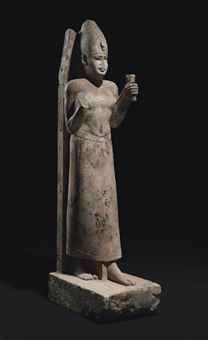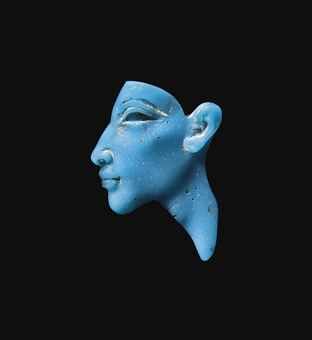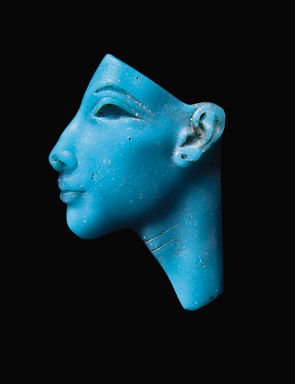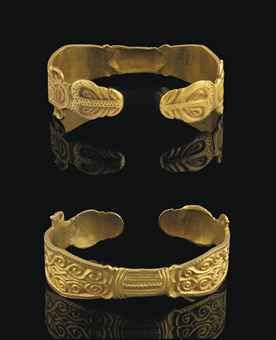Christie's announces its forthcoming Antiquities and The Groppi Collection sale
LONDON.-Christie’s announced the forthcoming Antiquities sale and The Groppi Collection, to be held on Thursday, 26 April 2012 at Christie’s South Kensington saleroom. Altogether featuring 397 lots, the auction is expected to realise between £5.8 million and £8.6 million. The April sale follows a successful 2011 for Christie’s Antiquities department, with sales totaling £8.74 million in London, a testament to Christie’s leadership in the European Antiquities market. The auction is led by The Groppi Collection – a family collection of ancient Egyptian artefacts originally formed by Achille Groppi between the 1920s-40s. Totaling 107 lots, the collection comprises a variety of objects, mainly rare Egyptian glass tiles, and is expected to realise £700,000 to £1,100,000.
An Egyptian glass face inlay of Akhenaten, New Kingdom, Amarna Period, Dynasty XVIII, circa 1353-1336 B.C. 1 5/8 in. (4.2 cm.) high . Estimate: £80,000-120,000. Photo: Christie's Images Ltd 2012.
The eye and eyebrow recessed, with enlarged pierced earlobe, the neck bearing traces of two 'vanity wrinkles'. Lot 29.
Provenance: The Groppi Collection, Switzerland; acquired in the 1920s-1940s.
Exhibited: Antikensmuseum Basel und Sammlung Ludwig und Museum August Kestner Hannover,Köstlichkeiten aus Kairo!, 2008, no. 54a.
Published: Exhibition catalogue, Köstlichkeiten aus Kairo!, Antikensmuseum Basel und Sammlung Ludwig und Museum August Kestner Hannover, 2008, p. 107, no. 54a.
An Egyptian glass face inlay of Akhenaten or Nefertiti, New Kingdom, Amarna Period, Dynasty XVIII, circa 1353-1336 B.C. 4.2 cm. high. Estimate: £80,000-120,000. Photo: Christie's Images Ltd 2012.
The eye and eyebrow recessed for inlay, with enlarged pierced earlobe, the neck with two lightly incised 'vanity wrinkles'. Lot 30.
Provenance: The Groppi Collection, Switzerland; acquired in the 1920s-1940s.
Published: Exhibition catalogue, Köstlichkeiten aus Kairo!, Antikensmuseum Basel und Sammlung Ludwig und Museum August Kestner Hannover, 2008, p. 107, no. 54b.
An Egyptian opaque red glass face inlay of Akhenaten, New Kingdom, Dynasty XVIII, circa 1353-1336 B.C. 1 5/8 in. (4.2 cm.) high. Estimate: £70,000-100,000. Photo: Christie's Images Ltd 2012.
With sensuous lips, recessed eye and eyebrow, pierced earlobe, faint traces of two 'vanity wrinkles' on the neck. Lot 31.
Provenance: The Groppi Collection, Switzerland; acquired in the 1920s-1940s.
Published: Exhibition catalogue, Köstlichkeiten aus Kairo!, Antikensmuseum Basel und Sammlung Ludwig und Museum August Kestner Hannover, 2008, p. 107, no. 54c.
Notes: For another red glass face inlay, cf. E.M. Stern and B. Schick-Nolte, Early Glass of the Ancient World, 1600 B.C.-A.D. 50, Ernesto Wolf Collection, Ostfildern, 1994, p. 142, no. 11). The throne back of Tutankhamun, with inlaid relief scenes of the pharaoh and his queen, shows the widespread use of glass inlays in this period (Cairo Museum, JE 62028).
The red glass inlay of the pharaoh's body might suggest his earthly functions, whereas the blue might suggest his celestial functions.
One of the most important lots in the sale, and the largest, standing at over 4 feet high, is an Egyptian limestone cult statue of Nectanebo I - the first king of the last dynasty in Egypt and the last major native pharaoh (estimate: £600,000-900,000). Dating to circa 380-362 B.C. this statue is an important addition to the corpus of royal sculpture from the Late Period – there are almost no examples that compare to this statue in terms of size, subject-matter and excellence of preservation. The Louvre has a head identified as Nectanebo I in its collections.
An Egyptian limestone cult statue of Nectanebo I, late period, dynasty XXX, reign of Nectanebo I, circa 380-362 B.C. 55.1/8 in. (140 cm.) high. Estimate: £600,000 -900,000. Photo: Christie's Images Ltd 2012
Standing with left leg advanced, wearing the White Crown with frontal uraeus, the oval face with almond-shaped eyes recessed for inlay, now missing, full cheeks, fleshy lips and rounded chin, with large finely carved ears, the arms bent at the elbow and raised, holding a lotus in his left hand, the fingernails delineated, right hand missing, with square shoulders and naturalistically modelled broad chest, the tear-shaped navel recessed, wearing a belted ankle-length kilt, the frontal fold incised, the long elegant feet with finely detailed nails, on an integral rectangular base, supported by a back-pillar, tapering towards the upper tip. Lot 140.
 Provenance: with Gallery Palamedes, Geneva, 1960s; acquired from a private collection, Switzerland.
Provenance: with Gallery Palamedes, Geneva, 1960s; acquired from a private collection, Switzerland.
Mr. J.-L. V. collection, Switzerland; acquired in the 1970s.
Property of a Gentleman, Europe, 1992.
Published: E. A. Feery et al., Art of the Two Lands: Egypt from 4000 B.C.-1000 A.D., New York, 2006, pp. 170-173, no. 59 (Dr. Robert Steven Bianchi).
Notes: Nectanebo I or Nakhtnebef (380-362 B.C.), was the first king of the last dynasty in Egypt and the last major native pharaoh. An army general from Tjebnetjer, his main priority, with the country living under the constant threat of Persian invasion, was to be, a 'mighty king who guards Egypt, a copper wall which protects Egypt'. (Naukratis stela, 11. 2-3. Cf. T. Wilkinson,The Rise and Fall of Ancient Egypt, London, 2010, p. 456). In a bid to restore the image of the monarchy which had seen a period of dynastic strife in the preceding years, he embarked upon an ambitious temple-building programme. He recognised that the temples controlled much of the country's wealth and that by investing in them he was improving the national economy. This in turn was an effective way of shoring up Egypt's defensive capability. An astute political ruler, Nectanebo appointed his son as heir and co-regent (365-360 B.C.) in order to ensure a smooth transition of power. See T. Wilkinson, op. cit., pp. 456-457.
This statue is an important addition to the corpus of royal sculpture from the Late Period. There are almost no examples that compare to this statue in terms of size, subject-matter and excellence of preservation. Although not inscribed, this statue can be dated to the Late Period and Dynasty XXX on stylistic grounds. For a head in the Louvre, also identified as Nectanebo I,cf. J. A. Josephson, Egyptian Royal Sculpture of the Late Period: 400-246 B.C., Mainz, 1997, pl. 2d.
Exceptional Provenance
The auction showcases works of exceptional provenance, including property from the Hubertus Wald Charitable Foundation and the estate of Renate Wald; and the collection of photographer Bob Willoughby, famous for his iconic portraits of his muse Audrey Hepburn. Unseen on the market in over thirty years, a Roman bronze chariot fitting in the form of a pantheress, circa 1st-2nd century A.D., is offered for sale from a Private Collection, having once graced the highly-esteemed collections of Baron Eugen Miller von Aichholz (1835-1919), Camillo Castiglioni (1879-1957) and Greta S. Heckett (estimate: £100,000-150,000). A Cypriot limestone male head, circa 460-450 B.C., was previously in the collection of Hector-Martin Lefuel (1810-1880) – architect under Napoléon III, whose most famous project was the completion of the Palais du Louvre, Paris (estimate: £40,000-60,000). Similar examples are in the Collections of the Metropolitan Museum of Art, New York and The Louvre, Paris.
A Roman bronze chariot fitting, circa 1st-2nd century A.D. 6¾ in. (17 cm.) long. Estimate £100,000-150,000.
In the form of a pantheress standing with mouth agape revealing a lolling tongue and teeth, with pointed ears, heavy teats, and a long tail curled over at end, with incised markings to indicate her coat and ribs, wearing a chest harness held with a circular clasp at back of neck, the rein guard in the form of a right-angled human finger supported on a spiral volute below, the integral rectangular base with an attachment socket on the underside. Lot 321
Provenance: Baron Eugen Miller von Aichholz (1835-1919) collection, Austria.
Camillo Castiglioni (1879-1957) collection, Vienna.
with Blumka Gallery, New York, 1956.
Greta S. Heckett collection, Pittsburg.
Ancient Bronzes from the Estate of Greta S. Heckett; Sotheby Parke Bernet, New York, 21 May 1977, lot 57 (front cover).
Private Collection, Switzerland.
Exhibited: Vienna, Archaeological Exposition, 1893, no. 1435.
Pittsburgh, Museum of Art, Carnegie Institute, Ancient Bronzes: A Selection From The Heckett Collection, 5 November 1964 - 10 January 1965, no. 75.
Published: L. Paniscig, Collezione Camillo Castiglioni: Catalogo dei Bronzi, Vienna, 1923, pl. 18, no. 5.
H. Ball and P. Graupe, Die Sammlung C. Castiglioni, Wein, Berlin, 1930, no. 268.
Exhibition catalogue, Ancient Bronzes: A Selection From The Heckett Collection, Pittsburgh, 1964, no. 75.
Notes: For similar examples cf. R. Fleisher, Die römischen Bronzen aus Österreich, Mainz, 1967, no. 249, and D. G. Mitten and S. Doeringer, Master Bronzes from the Classical World, Massachusetts, 1967, p. 290, no. 285. The harness that the pantheress wears indicates that she would have been one of the panthers drawing the chariot of Dionysos on his triumphal return from Asia, a scene most often found on Roman sarcophagi.
The hooked finger at the side secured or held straps or reins. These hooks took various forms including figural busts, leaping felines or more commonly duck heads. The use of the human finger might suggest some kind of apotropaic function to ward off evil spirits or bad luck.
A Cypriot limestone male head, circa 460-450 B.C. 13 3/8 in. (34 cm.) high. Estimate £40,000-60,000.
With curled hair and full beard, crowned with an olive wreath, the face with lidded almond-shaped eyes and an archaic smile, mounted on a 19th Century wood base. Lot 258
Provenance: Hector-Martin Lefuel (1810-1880), Paris; acquired circa 1870 and thence by descent.
Anonymous sale; Tajan, Paris, 28 March 2003, lot 29.
Notes: Hector-Martin Lefuel was a leading French architect during the Second French Empire. During his career he worked on Château de Meudon, Château de Fontainebleau, and Palais des Beaux-Arts et de l'Industrie, and received many honours inluding the Prix de Rome and Commander of the Légion d'honneur. His most famous project, however, was the completion of the Palais du Louvre under the order of Napoléon III. Throughout the long period of his involvement with the Louvre he received a series of gifts, including paintings and antiquities, from the museum. Although no records explicitly mention the present lot, it is possible that it was one such gift.
This head is part of an iconographic series mostly found in the Idalion-Golgoi region. Cf. V. Karageorghis et al., Ancient Art from Cyprus: The Cesnola Collection, The Metropolitan Museum of Art, New York, 2000, p. 211, no. 340 for a similar piece said to be found in Golgoi. For another similar head, also from the Cesnola Collection, cf. Louvre no. AM 3453.
And from a European Family, a Roman archaistic marble herm of Hermes Propylaios, circa 1st century B.C.-1st century A.D. (estimate: £50,000-80,000). The herm has been handed down through generations of the family since it was acquired circa 1896 by Don Fernando de Contreras and Francisca Pérez de Herrasti, Spain, from the sale of the property of Mariano Téllez Girón y Beaufort Spontin (1814-1882), 12th Duke of Osuna, Spain, Russia, and Belgium. A Knight of the Spanish Order of Toisón de Oro, The Duke attended Queen Victoria’s coronation and Napoléon III’s marriage to Eugenia de Montijo and was based in St Petersburg from 1856-1862. There he was known for his extravagant parties attended by all Russian nobility which caused the ruin of his great fortune and led him to auction most of his property.
The ownership in antiquity of this important Roman parcel gilt silver fluted bowl is known from the inscription on the base in Graeco-Bactrian, which reads ‘Property of Mawe-guzg’ –probably the name of the individual who commissioned the piece and suggests a date of around the 3rd Century A.D. (estimate: £300,000-400,000).
A Roman parcel gilt silver fluted bowl, circa 3rd century A.D. 9¼ in. (23.5 cm.) diam. 26 oz. (808 gr.). Estimate £300,000 - £400,000. Photo: Christie's Images Ltd 2012
With 32 deep flutes, the scalloped rim gilt, the interior with silver gilt tondo joined to the interior by six rivets, decorated with the raised repoussé head of a frontally facing satyr wearing foliate ivy wreath with berries, small horns on his forehead emerging through his wavy hair, with detailed eyes and long lashes, his brows knitted together with frown lines on his forehead, his lips parted in a grimace, bordered with two pecking birds below and ivy leaf tendrils running up the sides, and a wave pattern above his head and under his chin, the bowl on raised ring foot with rounded edges, incised concentric circles and an ownership inscription in Graeco-Bactrian cursive script reading 'Property of Mawe-guzg'. Lot 330.
Provenance: Private collection, Switzerland; acquired in the U.S.A. in the 1980s.
Notes: Bowls and dishes ornamented with central relief emblemata or medallions have been known since the early Hellenistic period. In Roman times these 'show pieces' were an indication of a family's wealth and status and would have been proudly displayed, the high relief decoration making practical use impossible. Such pieces would have been passed down as family heirlooms, treasured and collected.
Complete bowls are rare but detached emblemata have been found all over the Hellenistic and Roman world.
The Graeco-Bactrian inscription reads, 'maoêogozgi xobo', 'Property of Mawê-guzg'.
Gold Rush
The sale also includes, thirty-nine lots of ancient jewellery, ranging from affordable ancient intaglios and necklaces starting from around £1,000 to a spectacular Greek gold wreath, circa 3rd-2nd century B.C. estimated at £100,000-150,000. Formerly from Hever Castle in Kent, the wreath sold at Christie’s London in 1987 for £15,400. In antiquity, gold wreaths were frequently given as prizes for athletics contests, bestowed by the State as a mark of honour and glory. They were also used in religious processions, as funerary decorations and were popular dedicatory offerings made in temples. Further highlights from the jewellery section include a Greek gold snake armlet, circa 4th-2nd century B.C. (estimate: £80,000-100,000) and an Ostrogothic gold bracelet, circa late 5th-early 6th century A.D. (estimate: £80,000-120,000).
A Greek gold myrtle wreath. Hellenistic period, circa 3rd-2nd century B.C. 8¼ in. (21 cm.) diam. Estimate £100,000-150,000. Photo: Christie's Images Ltd 2012
Composed of four hinged gold bands, rounded on the exterior, flat on the interior, each decorated with long spear-shaped leaves with a central midrib, with fruit on delicate wire stems, each with a detailed filigree calyx, the terminals composed of beaded and twisted wire bands, row of tongues with twisted wire borders, three acanthus leaves with serrated edges and twisted wire borders, and two laurel leaves with beaded borders, with modern loops and an S-clasp closure. Lot 354
Provenance: Hever Castle, England, prior to 1987.
The Property of a Nobleman; Christie's, London, 11 December 1987, lot 19.
Private collection, Switzerland.
Notes: For a gold diadem in the Staatliche Antikensammlungen, Munich, composed of similar hinged gold bands cf. B. Deppert-Lippitz, Griechischer Goldschmuck, Mainz, 1985, pl. XXVIII. For another in the British Museum, cf. F. J. Marshall, Catalogue of the Jewellery: Greek, Etruscan and Roman, in the Department of Antiquities, London, 1969, pp. 170-171, no. 1609, pl. XXVII.
For a discussion on wreaths cf. D. Williams and J. Ogden, Greek Gold: Jewellery of the Classical World, London, 1994, pp. 35-36 where the author notes, 'The most elaborate items of jewellery were usually made for the adornment of the head...There were also gold wreaths (stephanoi). Examples of gold wreaths of oak, olive, ivy, vine, laurel and myrtle leaves are known from burials in Macedonia, South Italy, Asia Minor and the North Pontic area.'
Gold wreaths were frequently given as prizes for athletics and musical contests, bestowed by the State as a mark of honour. They were also used in religious processions, as funerary decorations and were popular dedicatory offerings made in temples.
A Greek gold snake armlet. Hellenistic period, circa 4th-2nd century B.C. 6¾ in. (17.2 cm.) long. Estimate £80,000 - £100,000. Photo: Christie's Images Ltd 2012
Formed of a spiralling band, with a medial row of stamped circles, representing the bodies of the snakes, each end with incised scales, one end terminating with pair of intertwining snake heads, decorated with four circular and one central leaf-shaped bezel, all with beaded wire borders, inlays now missing, the other end terminating with their tails, curving round and continuing along the body as a looped trail, decorated with two tear-shaped bezels, inlays now missing. Lot 353
Provenance: Private collection, London; acquired London art market, 1990s.
Notes: According to B. Deppert-Lipptiz, the bracelet is the rarest type of Greek jewellery to have survived. They were worn in pairs and could be remarkable in size, (D. Williams (ed.), The Art of the Greek Goldsmith, London, 1998, p. 91).
Snake bracelets became common during the Archaic period, when it was believed that snakes had amuletic properties and an association with the Underworld. The motif can be seen on female figures depicted on Athenian vases during the 6th and 5th Centuries B.C. However it was during the Hellenistic Period that there was a 'veritable explosion of the snake motif on jewelry', (R. S. Bianchi et al., Cleopatra's Egypt: Age of the Ptolemies, New York, 1988, p. 202), as Macedonian gold became abundant and the skill of the goldsmith reached its zenith.
For a pair of single snake bracelets with coiling tails cf. Masterpieces of the J. Paul Getty Museum: Antiquities, Los Angeles, 1997, pp. 64-65.
An Ostrogothic gold bracelet. Migration period, circa late 5th-early 6th century A.D. 3 in. (7.5 cm.) wide max. Estimate: £80,000-120,000. Photo: Christie's Images Ltd 2012
Solid cast, of pennanular form, the lozenge-shaped arms chip-carved with scrolls, the edges with a border of recessed interlocking triangles, the narrow middle section ridged with central strip of recessed interlocking triangles, the zoomorphic head terminals with tear-shaped eyes, a ridge with recessed interlocking triangles down the centre and across the top. Lot 375.
Provenance: G. F. Reber collection, Lausanne, 1928.
Bela Hein collection, Paris, 1940s.
Notes: The lozenge shape of this bracelet and stylised decoration consisting of scrolls, recessed triangles and zoomorphic motifs is typical of Ostrogothic decoration mainly found on fibulae. Bracelets from this period and with this type of decoration are rare. For fibulae with comparable decoration cf. exhibition catalogue, Germanen Hunnen und Awaren, Schätze Der Völkerwanderungszeit, Nuremburg, 1987, taf. 22, V,19 & V,23.a.
For a related Merovingian bow brooch with animal mask terminal, see Christie's, New York, 18 December 1997, lot 333.
Christie's. Antiquities. 26 April 2012. London, South Kensingtonwww.christies.com

/https%3A%2F%2Fprofilepics.canalblog.com%2Fprofilepics%2F1%2F0%2F100183.jpg)
/https%3A%2F%2Fstorage.canalblog.com%2F03%2F02%2F119589%2F96711876_o.jpg)
/https%3A%2F%2Fstorage.canalblog.com%2F11%2F31%2F119589%2F94773502_o.jpg)
/https%3A%2F%2Fstorage.canalblog.com%2F20%2F83%2F119589%2F94772815_o.jpg)
/https%3A%2F%2Fstorage.canalblog.com%2F26%2F72%2F119589%2F75604929_o.jpg)
/https%3A%2F%2Fstorage.canalblog.com%2F59%2F60%2F119589%2F26458628_o.jpg)












/image%2F1371349%2F20240423%2Fob_b2fe42_telechargement-9.jpg)
/image%2F1371349%2F20240423%2Fob_af8bb4_telechargement-6.jpg)
/image%2F1371349%2F20240423%2Fob_b6c4a6_telechargement.jpg)
/image%2F1371349%2F20240423%2Fob_981d5f_h22891-l367411650-original.jpg)